|
Hinduism
Astapanthana Maha Kumbabisegam of Maskeliya Sri Shanmuganathar
temple
S. Duraisamy Maskeliya Group Corr.
The Astapanthana Maha Kumbabisegam Vizha of 96 Years old Sri
Shanmuganathar Swamy Temple at Maskeliya in the Nuwara-Eliya District
was held on November 10, in a very grand way.
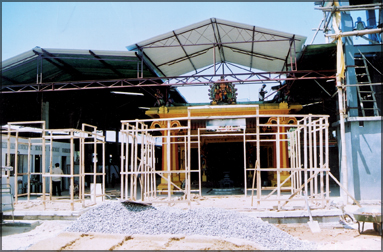 |
|
The proposed Sri Shanmuganathar Swamy
Temple at Maskeliya New Town and its re-constructional works
under way. Astapanthan Maha Kumbabisegam was held on
10/11/2008 in a very grand scale. |
This temple was built during the British Rule in 1912 at the Centre
of Old Maskeliya Town, which is in existence at the bottom of Sri Pada
the Holy Mountain in Sri Lanka. This temple has a history of 96 years,
in the Plantation area.
Maskeliya Sri Shanmuganathar Swamy is a worship place for Hindus
mainly and Buddhists too, in those good olden days. The temple was
located in the Main Street in Maskeliya on the way to Sripada from
Hatton on the land of Brownlow Estate.
It used to be a common centre to attract thousands and thousands of
Pilgrims and Hindus to Sripada. At the very beginning this was the only
temple for Hindus for worship and was called ‘Kutty, Kathirgamam’, by
devotees. Then this temple was administrated excellently by one
Chettiyappapillai, later was handed over to his son M.T.C. Sivalingam
Pillai.
At the main Peedam there is the Idol in the country of God Sri
Shanmuganathar Swamy with six faces carved on a single stone brought
from India. It was told that this is the second Idol carved with six
faces of Shanmuganathar Swamy in one stone. The other said to be in
Northern Peninsula.
During the Sripada season, this Hindu temple had become a worship
place for Buddhist Pilgrims too. This old Hindu Temple was submerged in
water along with the entire Maskeliya Town, under the inundation of the
Maskeliya Oya Hydro Power Project in the year 1968.
All idols in the temple were brought to the new town and kept for
worship. After the temple was built in 1977, the first Maha Kumabisegam
was held in 1977, May. and it was conducted by the then Trastee Board
led by P. Karuppiah Pillai.
Today this temple has got idols of Sri Shanmuganathar Swamy with
Godsses Vallie and Deivanai on both sides of the Chief Idol. It is a
very beautiful and colourful scene to devotees.
Apart from the main Idol of God Shanmuganathar Swamy, several other
idols of Gods and godesses are installed inside the Temple premises for
the convenience of people for worship.
The other idols are as follows; Sri Shanmuganathar Swamy with Valli
and Deivanai, Sri Vinayagar, Sri Muthumariyambal, Sri Maha Vishnu, Sri
Narthana Kanapathy, Sri Thatchana Kanapathy, Sri Prema, Durgai Ammal,
Sri Iyappan, Sri Sivagambigai Ammal, Sri Nadarajan, Sri Kandalwar, Sri
Anjaneyar, Navakiragams (Nice Idols), Sri Vairavar, Sri Karuppannan, Sri
Nagathambiran, Sri Idumban, Sri Sandeshwarar, Sri Lingothpawar, Sri
Sandana Gopalar, and idols of gods and godesses that are being taken in
procession during festivals.
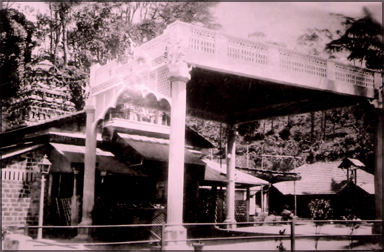 |
|
The old Sri Shanmuganathar Swamy
Temple at old Maskeliya Town which was submerged in
Mousakelle Reservoir, that was built under the Maskeliya Oya
Hydro Power Project in 1968. Pictures from: S. Duraisamy,
Maskeliya Group Correspondent |
Every Year, festivals such as Pongal, Deepawali, Margali Poojas,
Adipooram, Iyappan Pajans, Nawarathri, Adipooram, Saraswathy Poojas,
etc, are conducted according to Hindu Religion, Culture and Rites.
Apart from this, this temple has got three beautiful and colourful
Thers (Chariots) and they are being drawn from the Temple premises
through all streets of Maskeliya Town during the Panguni Uttaram, which
falls on the month of April, every year.
Foreign Diplomats, Ministers, Leaders and dignitaries and also
foreign Tourists who are on their way to Sripada stop at Maskeliya and
they never fail to worship this Hindu temple. In 1988, a new Board of
Trustees was formed from public of Maskeliya Town. T. Raju was elected
as President, K. Krishnanmoorthy Proprietor of Central Jewellers,
Maskeliya as Secretary and P. Velusamy, Proprietor of Siva stores as
Treasurer and 15 executive members were elected to the Board.
Now they are performing their duties towards the progress and
development of this beautiful Hindu Kovil. This Kovil has become a main
worship location to thousands and thousands of people of the area and is
one of the leading Hindu Kovils in the Plantation area.
Ven. Sri S. Sivasangara Kurukkal is the Chief Kurukkal.
Hindu saints and the bakthi cult - 9:
Vaishnava Saints: Women saint Aandal
T.V. Vijeyaratnam
There was a devoted Vaishnavaite called Pattanathar who went to the
garden daily to collect flowers and string them into a garland for Lord
Vishnu. One day when he was searching for some Thulasi (Basil) leaves -
a favourite of Lord Vishnu - he found an infant among the herbs. As he
wondered how this baby came to be there, the infant seemed to say
something to him in its infant tongue. He was thrilled to see it was a
child and not a doll and carried the baby to his wife. While she fondled
the child she felt she could breast feed her which was a wonder as the
baby was not born to her. Pattanathar named her ‘Kothai’.
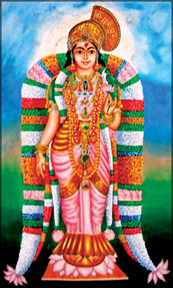 Kothai from childhood worshipped Sri Krishna and yearned to be
married to him. She saw Krishna in everything that met her eyes. Kothai from childhood worshipped Sri Krishna and yearned to be
married to him. She saw Krishna in everything that met her eyes.
Her father Pattanathar had special garlands made for Sri Krishna.
Kothai would take the garland wear it herself and see herself in the
mirror to see how it would look on Krishna or Kannan and would remove
the garland before her father came for it. One day as she decked herself
with a garland, her father saw her and thought it was sacrilegious to do
so. He didn’t take the garland that day to Lord Vishnu.
That night in his dream Lord Vishnu appeared and asked him the reason
for not bringing the usual garland. He told Lord Vishnu the reason for
which Lord Vishnu replied, “The garland worn by Kothai is the one I like
most.”
When Patanathar awoke, he was astonished at what he saw and heard in
the dream. “Is my daughter Sri Lakshmi’s incarnation” he wondered. From
that day onwards he would give the garland to Kothai to wear before
taking it to the shrine. Kothai’s love for Krishna was so sincere that
the Lord accepted her devotion. “You are my ruler - Aandal”, He told
Kothai. From then on she became known as Aandal - one who ruled.
When she came of age the parents thought of a marriage for her and
were looking out for a suitable groom. Knowing this Aandal addressed her
father, “Father I’ll not marry a mortal. It is the great Vishnu who
would marry me”.
The father was aghast, “Is it possible”, he asked. Anyway the parents
didn’t proceed to find a partner for her. Seeing her pining away for
Krishna, her father asked her, “My child some people like to hear of His
great qualities, and some like to hear about His life as Rama, yet a few
others would like to hear of Him as Yamodai’s son. What would you like
to hear of?” To which Aandal replied, “My father, I like to hear about
the 108 shrines of my Lord.” So the father related the accounts of all
these shrines in the North and South. Aandal asked, “Which of these 108
shrines in the most famous?” The father told her it is “Sri Rangam in
Trichy”. Aandal sang 143 Pasurams on Sri Krishna.
Her father on seeing her misery, prayed to Lord Vishnu to come to her
aid. Sri Banganathar appeared in his dream and told him, “I will marry
Kothai. You bring her to Thiru Arangam.”
Lord Vishnu also appeared in the dream of the Temple Trustee and
commanded him to go with a retinue and receive the bride’s party. The
Lord also appeared in the dream of the Pandya king Vallabadevan and told
his to bring Kothai in a palanquin to pearls to Thiru Arangam.
Kothai was ecstatic when her father told her about the dream. People
from Thiru Arangam came to his house with all fineries for Kothai. They
told him about Lord Vishnu’s command and said they came to take the
bride to Thiru Arangam. Pattanthar was awestruck at the Lord’s concern
for His devotees and shed tears of joy.
On the orders of the Pandya King, his courtiers spread the news of
the on-coming marriage and decorated the path from Pattanathar’s home to
the temple premises.
All the ceremonies connected with Hindu traditional marriage were
done and the bride was taken with all pomp and splendoar.
The bride and her parents were received by the Pandya King who told
the trio about the dream he had. This further added to the awe and
wonder the parents felt.
On reaching the nuptial chamber Kothai stepped out from the palanquin
and standing next to Lord Vishnu embraced him and miraculously
disappeared into His physical form. This is in fact the spiritual union
of the Jeevathma with the Paramathma. All who came to watch the event
were speechless. Pattanathar lamented, “Oh My Lord, Thou has made my
child disappeared. Is it fair of Thee?” They heard an oracle, “Do not
worry - see her seated beside me in the sanctum sanctorum.” They looked
and saw Thiru Aranganather, with him on his left was Lakshmi and Neelai
on the other side and Kothai was there between them. Lord Vishnu
instructed Pattanathar to go back to his place and continue making
garlands for Him. The king and his retinue and all those gathered there
vowed it was mother earth (Poomahal) who took the form of Kothai - who
has found a place beside Lord Vishnu.
They sang and danced in ecstasy at this wonder and worshipped Lord
Vishnu and departed to their respective dwelling places.
Aandal was canonized a Vaishpava Saint. Her life and Love for Lord
Vishnu is still sung and presented in ballet form.
A sincere devotee would always be accepted by Lord God is what her
life has taught us.
The Human being in the eye of the Hindu
Ancient Hindu texts, particularly the Upanishads, perceived the
individual self or “atman” as the immortal pure essence of each being.
All human beings are positioned in the all-embracing “Brahman” or the
Absolute, frequently linked with the cosmic dimensions of the universe.
Hindus have great devotion for the Brahman and their locus in the
caste system and associated duties to God and society are inherent
components of their existence and spiritual pursuit. Ultimately, all
human beings are Divine and each being has the power of awareness,
sacrifice, and adherence to the divine order.
Thereby, Hindus, having the responsibility to actively represent
their respective and God given caste, community, and family, consciously
attempt to uphold the purity of their eternal atman.
As a concluding text of the Vedas, the Upanishads incited intense
philosophical speculation of religious and ritualistic practices and the
universe. In these divine texts, God was defined one as Brahman (Brihadaranyaka
Upanishad III.9.1.9).
The concepts of atman and Brahman were differentiated through
discussions between students and teachers and a particular deliberation
between a father and his son. The atman was described as the supreme
universal self and the deepest essence of each being while the
overarching Brahman pervades the individual. The physical portion of the
human being is conceptualized as the human body, a vulnerable vehicle
within the ceaseless atman.
Carefully elaborated in the Vedas and principally produced in the
Laws of Manu, the divinely ordained duties of human beings in accordance
to caste system or “varnashrama-dharma” were identified in fours
distinct orders (varnas). In an ideological framework, the castes were
defined as priests and teachers (Brahmin), rulers and warriors (Kshatriya),
merchants, craftsmen, and farmers (Vaishyas), and servants (Shudras).
The heart and very definition of the Hindu society is the varnashrama-dharma
model, a balanced institution of substance welfare, education, moral or
dharmic pursuits. Regardless of caste, all beings have the ability to
move towards enlightenment by their life actions or karma and
progression via cycles of rebirth (samsara). Every member of each caste
is written in the Rig Veda to be a manifestation or derivative of the
universe symbolized by the embodied human spirit Purusha:
As the longest epic poem in the world, Mahabharata depicts the
actions of Hindu human beings in times of dharmic conflict in a power
struggle between two groups of cousins.
The incarnate Lord Krishna states that although he has absolute
authority over the universe, human beings must perform the duties
themselves and reap the benefits. Furthermore, in the ideal Hindu
society, human beings ought to accept their “varna” and live life
accordingly. Krishna’s dialogue with the people of different varna in
the Bhagavad Gita, a part of the Mahabharata, instructs self-realization
and reaffirms “varnashrama-dharma”.
It describes the human body as a suit of clothes on the atman, for
the atman merely inhabits the body and assumes a new one after the death
of the first. The precious atman must be cleansed and maintained pure by
abiding to regulations set forth in the Vedas.
The God of the Hindu tradition selected human beings, their own
creations, to uphold a system of dharma and thus Hindu life. As a direct
consequence, Hindus benefited from their obedience to such social order.
Under the guidance of the Vedas, the creation of a prosperous society
with members incited to act by the bounds of law, justice, virtuousness,
and all-embracing dharma, could achieve liberation. Human beings with
spiritual guidance by direct prayer, readings of the Vedas, guru
lectures, and familial observation, have a divine right to accomplish
“moksha” or liberation.
 |
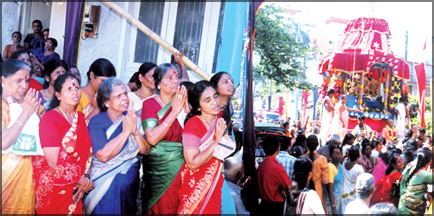 |
A special Navarathiri
Pooja ceremony for Goddess Saraswathi, organised by the
Hindu priests’ training centre (Kurukulam) students
affiliated to the Sri Vidya International Hindu Religious
Peedam was held at Sarwartha Sithi Vinayagar Kovil, Colombo
15 recently. Here students perform pooja with chief priest
R. Babu Sarma.
Picture A. Maduraweeran |
The Annual Sri Jaganathar ‘Ratham’
festival organised by the Hare Krishna International Krishna
Bakthi Kalagam (Colombo branch) took place recently. Here
the ‘Ratham’ carrying the deity of Lord Krishna being taken
in a procession with devotees from Radhakrishna Kovil along
New Chetty Street Colombo 13. Picture A. Maduraveeran |
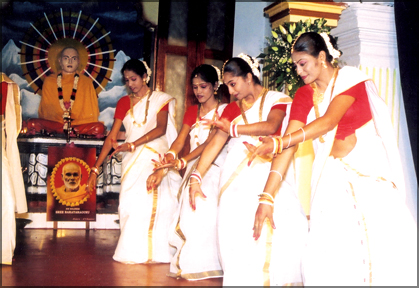 |
|
A Dance Programme was organised by the
Sri Narayana Guru Society (Sri Lanka Branch) to mark Sri
Narayana Guru’s 115th birth Anniversary at the Sri Narayana
Guru Memorial Hall, Grandpass recently. Picture A.
Maduraveeran |
|



